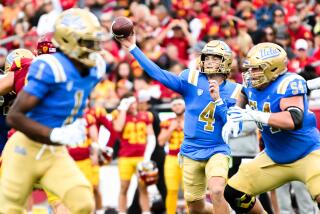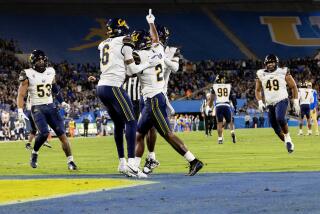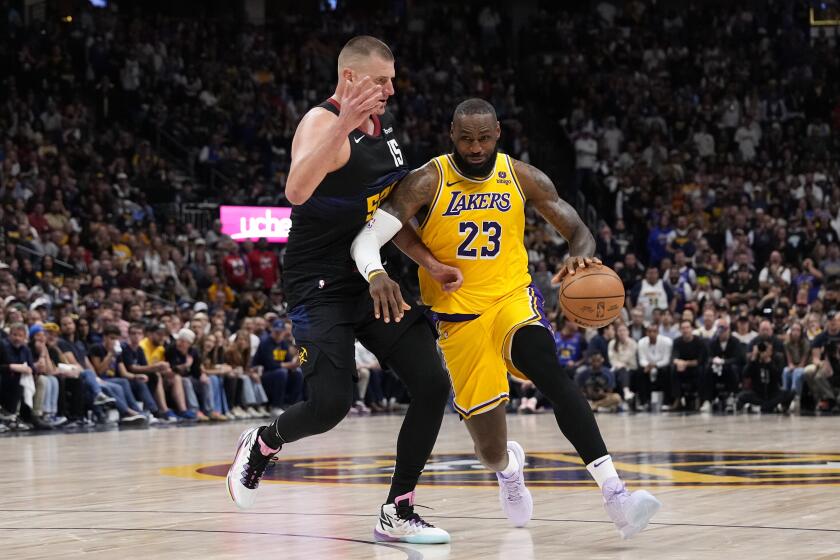NCAA’s pay-for-play proposal has its supporters and detractors
College football seemed so easy for Robert Woods.
The bigger players and harder hits, the roaring crowds, he sailed through all of that to become an instant star at USC, catching passes by the dozen as a freshman.
It was another part of the game — a part fans don’t see — that took him by surprise. It was the peanut butter and jelly.
“You think, coming to USC, they’ll have food whenever you want but it’s really not like that,” he said. “I’ve gone four days straight of just sandwiches.”
Now a sophomore, Woods has learned that bills — rent, utilities, and phone — devour most of his monthly scholarship check, leaving only dollars a day to eat. The team feeds him dinner during the season, but the rest of the time, he says, “you’re on your own.”
This dilemma affects student-athletes nationwide. According to a 2010 study, the maximum financial aid allowed under NCAA rules can fall short of covering school and living expenses by anywhere from $200 to $10,000 a year, depending on the campus.
At USC, Athletic Director Pat Haden estimates that his athletes need another $3,300 to meet basic needs. “It doesn’t seem right,” he said. “And I think it’s a public relations nightmare.”
With the Pac-12 Conference and other major conferences set to reap billions from new television contracts, the NCAA board of directors recently announced that members will have the option of boosting aid by as much as $2,000 a year.
That makes sense to Woods, who says, “All these universities are making money off their players.”
But not everyone is thrilled with the change. Some do not believe $2,000 is enough. Others contend that larger scholarships will put a strain on small schools and shift everyone a step closer to pay-for-play.
Whenever college sports and money intersect, there are no easy answers.
Equality for none?
Hard times are not hard to see. All Robert Kustra has to do is step off the Boise State campus for a bite to eat.
“My students are working for minimum wage in restaurants, collecting as much in tips as they can,” the university president said. “Many of them literally have to drop out for a semester to raise money for the next semester.”
By comparison, athletes have it pretty good, he believes. Their scholarships might not cover everything, but they get tuition, books and housing. Also, academic tutors help them with schoolwork.
“How many of our regular students have a full ride?” he asked. “Where’s their extra stipend?”
Critics of the new NCAA legislation worry that growth in spending will exacerbate the so-called “arms race,” rival athletic programs scrambling to outdo each other with glitzy training facilities and enormous coaching salaries. The gap between the haves and have-nots has widened.
The NCAA has encouraged its members to vote on increased aid by conference. The big schools — the ones from the Pac-12, Big Ten, Southeastern Conference, etc. — are expected to adopt the change.
Smaller conferences with modest television deals might struggle to come up with the money, said David Ridpath, an Ohio University assistant professor and member of the watchdog Drake Group.
“Will it benefit Ohio State more than Ohio University? Yes,” Ridpath said. “Is it going to make the rich get richer and bring down the small schools? Absolutely.”
Boise State currently belongs to the small Mountain West Conference. Yet, when it comes time to vote, Kustra could be put in the uncomfortable position of supporting an increase.
The reason is simple: Over the past few seasons, his football team has beaten the odds by forcing its way onto the national stage and he does not want to give the competition a recruiting edge.
“When my coaches go into a living room and the parents compare what their student will get in the Pac-12 or the SEC,” he said, “they’re not coming to Boise State unless we give them the same thing.”
Food for thought
It was just last summer that Haden bumped into several football players outside the athletic department.
“They were literally hungry,” he said. “They asked if there was any free food on campus.”
At first, the athletic director was skeptical. He called eight or so athletes into his office — including Woods, tight end Xavier Grimble and cornerback Anthony Brown — to review their finances, comparing scholarship checks against monthly bills.
“It may have seemed like we were going out, buying clothes and things like that,” Woods said. “He could see that we weren’t.”
Instead, Haden found that things had changed radically since he was a star quarterback for the Trojans in the 1970s.
Back then, players worked summer jobs to save for the coming school year. Now, they are expected to spend that time training. With more film work and conditioning during the season, they use the rest of the year to take their hardest classes.
“Let’s just call it what it is,” said Ridpath, who refers to modern college sports as “a commercialized, para-professional enterprise.”
Much like Kustra at Boise State, the Ohio professor finds himself conflicted. He opposes increased athletics spending, yet sees that players need help.
At USC, Haden did the math and found that his athletes spent $600 to $950 a month on rent, some of them sharing rooms with teammates. After the usual bills, about $150 remained.
Five dollars a day wasn’t enough to feed young men and women who worked out constantly, especially football linemen accustomed to consuming 5,000 or more calories.
NCAA rules prohibited Haden from giving them food. And he estimated that almost a third of his athletes received no help from home.
“Those are the kids I worry about most,” he said. “We have to do what’s right.”
Extra investment
When Sidney McPhee agreed to help the NCAA assess athletic scholarships, it felt like familiar territory.
McPhee is president of Middle Tennessee State, where 84% of students receive some type of financial help. He says university administrators frequently review academic scholarships “to see how competitive we are with regards to attracting the best and the brightest. In many cases, we make adjustments up.”
It surprised him that the NCAA had not reviewed its aid policies “for decades.”
But where sports are involved, emotions can muddy the discussion and officials now find themselves answering questions that have nothing to do with dollars and cents.
Asked about competitive balance, NCAA President Mark Emmert cited a study by the respected Knight Commission that showed Division I schools vary widely in how much they spend per athlete, the numbers ranging from approximately $40,000 to $160,000 a year.
An extra $2,000 in financial aid, Emmert said, “is not going to have any impact.”
He also dismissed concerns that college sports are moving closer to professionalism.
“The dividing line on pay-for-play is very sharp and clear,” Emmert said. “This is about trying to cover more of the legitimate expenses.”
In addition to increased aid, the NCAA recently adopted legislation that toughens academic standards for student-athletes and allows universities to offer multiple-year scholarships, a departure from the traditional year-by-year model.
McPhee put the money issue in simple terms.
“This is not unusual in higher education,” he said. “We do it quite regularly on our campuses.”
Better than nothing
Before he gets started, Jeff Locke wants to make something clear.
As a punter on the UCLA football team — and an economics major — he appreciates the value of his athletic scholarship.
“I’ll be the first to tell you that my future earning potential has gone up ten-fold by getting a UCLA degree,” he said. “I know how blessed I am.”
But Locke got what he describes as “a wake-up call” not long ago. Running out of money at the end of the month, he looked around to see other teammates in the same predicament.
“This is a multibillion-dollar industry,” he said, “and these players don’t have enough to buy groceries.”
The redshirt junior now works as an intern for the National College Players Assn., a grass-roots organization created by former Bruins linebacker Ramogi Huma. It was the NCPA, with help from Ithaca College in New York, that conducted the 2010 study on scholarship shortfalls.
The group recently presented the NCAA with a petition signed by more than 300 college athletes asking for a mandatory — not voluntary — $3,200 boost in financial aid.
That figure is slightly less than UCLA’s estimated $3,443 shortfall. Locke contends the NCAA failed to sufficiently address the problem.
“They need to understand,” he said. “That still leaves 100 schools out there with players not receiving the full cost of attendance.”
Across town, at USC, Woods knows an additional $2,000 will not cover all of his expenses. But he views the situation from a slightly different angle.
At this point, he will take whatever he can get.
“The money will make a big difference,” he said. “We can eat.”
twitter.com/LATimesWharton
More to Read
Get our high school sports newsletter
Prep Rally is devoted to the SoCal high school sports experience, bringing you scores, stories and a behind-the-scenes look at what makes prep sports so popular.
You may occasionally receive promotional content from the Los Angeles Times.







